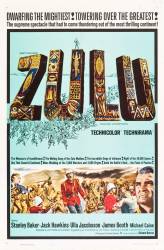Corrected entry: In the final Zulu attack, the lieutenant tells the men to fire when the Zulus get to 100 yards. He shouts "Fire" and about two seconds later the Zulus are jumping on the sandbags. It is impossible to cover 100 yards in two seconds.
Corrected entry: On several occasions, troopers are seen breaking open ammunition boxes. After the lid is removed, it is clear the rounds of ammunition are covered in a layer of aluminium foil. In one scene, the trooper handing out the ammunition even tears the foil open. I doubt aluminium foil existed in those days.
Correction: I believe that was lead (not aluminium) foil, which did exist at the time and was used for sealing purposes. Tin foil also existed at this time.
Corrected entry: Even though Lt. Bromhead shot a cheetah, the porters carry a dead leopard back to camp.
Correction: He missed the cheetah.
Corrected entry: During the prologue, the narrator (Richard Burton) reads from the military report that 1,500 men were lost at Ishandwana. However later on, when Chard and Bromhead meets Ardendorf, Ardendorf says that 1,200 men were lost---800 British soldiers and 400 native levies. So is it 1,500 or 1,200? The numbers don't tally.
Correction: Ardendorf's report to Chard and Bromhead would had been an estimate. I don't think he would had hang around to count the total loss! Where as the military report was compiled sometime later after the battle when a full account of the loss would had been measured.
Corrected entry: It's very unlikely that the red coats the British wore would have been so red in the dusty and sandy conditions of South Africa, yet they always seem to be so clean. Also, the white helmets were often dyed with tea so troop movements were harder for enemies to spot.
Correction: "Unlikely" doesn't mean impossible. "Often" doesn't mean always. These men were military, maintenance of their kit was drilled into them day and night.
Corrected entry: Before the first attack when the camp outside of the missionary station is dismantled, a group of soldiers double time it down the dirt track. As they go past a tent, one of them trips on one of the tent guide ropes and nearly falls flat on his face.
Correction: People trip in real life. Not an error.
Corrected entry: Chard was in the Royal Engineers. Their tunics were blue, not red.
Correction: The blue tunic for the Engineers was not introduced until later on in the century. Chard did indeed wear red that day. Note: All British officers at this time did have a blue "patrol jacket" that was worn usually off duty.
Corrected entry: Why are the engineers building a bridge when Michael Caine's character fords the river at about ankle depth 20 yards downstream?
Correction: Why indeed - but that's not the film's mistake - they are simply showing a historical event as it happened. Strange as it may seem, Liuetenant Chard's mission was to build a bridge across the river near Rourke's Drift, and he was in the middle of it when events overtook him and his men.
Corrected entry: Instead of leaning out the window to fire at the Zulus when they were attacking under cover of darkness, why didn't those two hospital guards stand aside and bayonet the Zulus one by one as they climbed in through the window? They could have saved their own lives by doing so.
Correction: Because that's what they did in real life. They were hospital orderlies, not trained infantrymen. Frightened people don't think with logic and calm precision while under fire.
Corrected entry: The soldiers wear parade dress uniforms, including white helmets displaying the regimental crest. On active service, they would have worn a more basic uniform with plain cork helmets, as correctly depicted in ZULU DAWN.
Correction: The white helmets were worn during the Rorke's Drift battle per Private Henry Hook's personal account: http://www.rorkesdriftvc.com/vc/hook_account.htm. It does seem unlikely, though that the rest of the parade dress uniform would have been worn in a remote post in South Africa.
Corrected entry: Some of the Zulu generals were standing out on hilltops in open view when shouting commands to the Zulu armies. Strange that none of the British riflemen thought of getting a good, clean shot at them from afar...
Correction: The Martini-Henry .45 caliber rifles used by the British could shoot through a man at 200 yards. Despite this the generals on the hill are out of range.
Corrected entry: Hook calls a character "you long range sniper you." This specific term was coined in WWII as a derogatory term for artillery well behind the lines.
Correction: The word sniper dates from 1824 and the verb from 1782 both derived from the bird of the same name which was first recorded in about 1325. Snipe was even used as an abusive term in Shakespeare's Othello. Further, the verb took on a figurative sense by the late 19th century: to verbally rebuke or criticize (to "shoot" at with words).






Correction: When Bromhead says "at 100 yards" you see several soldiers adjusting their rear sights. He is referring to a sight setting, not actual distance. The sights slide on a "ramp" I'll call it, that are set to compensate for bullet drop at different distances.
Steve Kozak